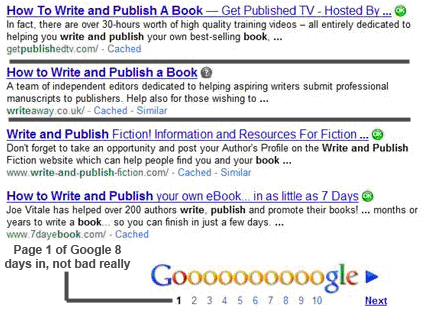Search Engines Results Experiment – An Update
2So how many times have you seen this, you make an initial attack on a keyword phrase, build some links using in context linking techniques, submit to a couple of social book marking sites and hey presto there you are on page 1 of the Google search engine results page. So that’s it, job done and what was all the fuss about?
 If only it was that easy, because what happens next is that you check again a few days later and you are nowhere to be seen. Some gurus tell you getting on page 1 of Google is easy and you can do it in hours using the right techniques. And yes they are right, but that is not what it is about, it is about getting prime position on the search engine results pages and then staying there, indefinitely.
If only it was that easy, because what happens next is that you check again a few days later and you are nowhere to be seen. Some gurus tell you getting on page 1 of Google is easy and you can do it in hours using the right techniques. And yes they are right, but that is not what it is about, it is about getting prime position on the search engine results pages and then staying there, indefinitely.
.
This takes a lot longer and requires an ongoing and steady campaign utilising a range of different techniques combining both on page optimization and off page optimization.
There is no doubt that you must know what keywords or phrases you are targeting and that you must optimize your URL page for the terms(s) chosen. That is you get them into locations that give you the most bang for your buck, such as the URL itself and then then the title. After that you can include all or part of your chosen keywords throughout your headings, text and alt tags for graphics. This is what is called taking care of some of the aspects of on page optimization.
So what is off page optimization? In a word, the most important off page optimization activity is building back links, ideally back links that use anchor text to link to your URL page. There are a lot of ways to build back links many of which are described in this post on back linking strategies.
By the way, this is how you create a back link using anchor text in html:
<a href="https://blogaude.com/website-search-optimization-link-building-strategies/">Back Linking Strategies</a>
The phrase ‘Back Linking Strategies‘ is the anchor text and the ‘<a href= etc.’ is used to define it as a link.
So yes we saw a brief glimmer of an amazing success for a fairly competitive term and of course we know that this success can be repeated. But now we also know we have to put in the hard work and concentrate on the off page optimization, in other words get those links in place and in numbers. As a final word, it is worth noting that many of the sites that have displaced our experiment do contain either the complete keyword phrase selected in their URL or at least some of it. Pretty much tells it how it is, identifying the keyword phrase and building it into a domain name certainly helps the cause.
This is absolutely the key for longevity! 99% of the “advisors” out there either don’t know, or totally neglect, the part about anchoring the keyword with back links. There are a few blogs as strong as their website counterparts, and they do this by actively marketing the blog. Thank you for bringing this issue forward.
Hi Jason, yes you are right and this is a neglected area with not enough people using this valuable off page optimization technique. The reason why is pretty clear as well, I think, and that is because it’s not easy to do. Getting someone to give you anchor text on their website or blog with the required keyword phrase can be hard to achieve, one method of course is to offer a guest post with your anchor text built into the resource section. Another old fashioned, but still effective method, is to use article directories. The key to success with both these techniques is to write a quality article that someone is happy to use on their own website or blog.
Another way of getting anchor text links is to sign up to a resource such as HubPages or perhaps Squidoo. You can publish your articles on a range of topics and insert links to your target sites using your anchor text. There are limits as to how many you can post within a single hub(2) or lens(9) going to the same domain, but you have got total control other than that. There are a number of other sites similar to these, but they are the main two.